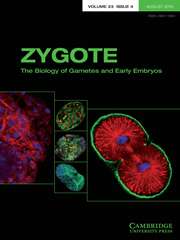A novel method for isolating spermatid nuclei from cytoplasm prior to ROSI in the mouse
Published online by Cambridge University Press: 04 February 2005
Abstract
In the current widely used round spermatid injection (ROSI) protocol for the mouse, the spermatid nucleus is separated from most of the cytoplasm before ROSI by drawing a spermatid in and out of a pipette. This results in the highest rate of normal fertilization. However, this separation method is not always consistent and can be time-consuming. An alternative separation method that cuts away the cytoplasm using the tip of an injection pipette was developed. After removing the cytoplasm, ROSI was performed following both post- and pre-activation protocols and development in vitro and in vivo were examined. The new method consistently removed the bulk of the cytoplasm, as shown by quantifying mitochondria. ROSI without the cytoplasm resulted in significantly higher rates of fertilization than ROSI with the cytoplasm into either post- or pre-activated oocytes. Furthermore, the offspring production rates of ROSI without the cytoplasm were also high (50% and 49% for the post- and pre-activation protocols, respectively). This new method for separating the cytoplasm is an alternative way of producing offspring using ROSI.
Keywords
Information
- Type
- Research Article
- Information
- Copyright
- 2004 Cambridge University Press
- 9
- Cited by

